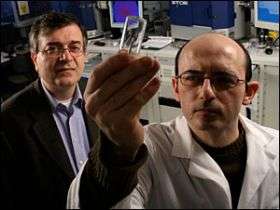New Material Can Find a Needle in a Nuclear Waste Haystack

Nuclear power has advantages, but, if this method of making power is to be viable long term, discovering new solutions to radioactive waste disposal and other problems are critical. Otherwise nuclear power is unlikely to become mainstream.
A team of Northwestern University chemists is the first to focus on metal sulfide materials as a possible source for nuclear waste remediation methods. Their new material is extremely successful in removing strontium from a sodium-heavy solution, which has concentrations similar to those in real liquid nuclear waste. Strontium-90, a major waste component, is one of the more dangerous radioactive fission materials created within a nuclear reactor.
The results will be published online the week of March 3 in the Proceedings of the National Academy of Sciences. By taking advantage of ion exchange, the new method captures and concentrates strontium as a solid material, leaving clean liquid behind. In the case of actual nuclear waste remediation, the radioactive solid could then be dealt with separately -- handled, moved, stored or recycled -- and the liquid disposed.
“It is a very difficult job to capture strontium in vast amounts of liquid nuclear waste,” said Mercouri G. Kanatzidis, Charles E. and Emma H. Morrison Professor of Chemistry in the Weinberg College of Arts and Sciences and the paper’s senior author. “Sodium and calcium ions, which are nonradioactive, are present in such enormous amounts compared to strontium that they can be captured instead of the radioactive material, interfering with remediation.”
Strontium is like a needle in a haystack: sodium ions outnumber strontium ions by more than a million to one. The material developed at Northwestern -- a layered metal sulfide made of potassium, manganese, tin and sulfur called KMS-1 -- attracts strontium but not sodium.
“The metal sulfide did much, much better than we expected at removing strontium in such an excess of sodium,” said Kanatzidis. “We were really amazed at how well it discriminates against sodium and think we have something special. As far as we can tell, this is the best material out there for this kind of application.”
KMS-1 works at the extremes of the pH scale -- in very basic and very acidic solutions, the conditions common in nuclear waste -- and everywhere in between. Metal oxides and polymer resins, the materials currently used in nuclear waste remediation, perform reasonably well but are more limited than KMS-1: each typically works in either basic or acidic conditions but not both and definitely not across the pH scale.
In earlier work, Kanatzidis and his team had found KMS-1 to be very quick and facile at ion exchange. (The material gives up an ion and takes another to maintain charge balance.) Knowing this and also that the ion exchange process is a removal process, the researchers decided that strontium was an interesting ion with which to test their new material.
The solution the researchers used in the lab contained strontium and two “interfering” ions, sodium and calcium, in concentrations like those found in the nuclear waste industry. (Nonradioactive strontium, which works the same as the radioactive version, was used in the experiments.) KMS-1, a free flowing black-brown powder, was packaged like tea in a teabag and then dropped into the solution. The all-important ion exchange followed: the metal sulfide “teabag” soaked up the strontium and gave off potassium, which is not radioactive, into the liquid.
KMS-1 does its remarkable work targeting only strontium by taking advantage of two things: strontium is a heavier ion than calcium, and sulfur (a component of KMS-1) attracts heavier ions; and KMS-1 attracts ions with more charge so it attracts strontium, which has a charge of 2+, and doesn’t attract sodium, which only has a charge of 1+. So, as Kanatzidis likes to say, “Our material beats both sodium and calcium.”
“The nuclear power process generates enormous amounts of radioactive liquid waste, which is stored in large tanks,” said Kanatzidis. “If we can concentrate the radioactive material, it can be dealt with and the nonradioactive water thrown away. I can imagine our material as part of a cleansing filter that the solution is passed through.”
Looking to the future, to be a scaleable and affordable remediation method, the metal in the metal sulfide needs to be inexpensive and readily available and also make a stable compound.
“We focused on potassium, manganese and tin because we have been working with them for some time,” said Manolis J. Manos, a postdoctoral fellow at Northwestern and lead author of the paper. “All three metals make stable compounds and are common and abundant.”
“Our next step is to do systematic studies, including using an actual waste solution from the nuclear power industry, to learn how KMS-1 works and how to make even better metal sulfides,” added Manos.
Source: Northwestern University
















